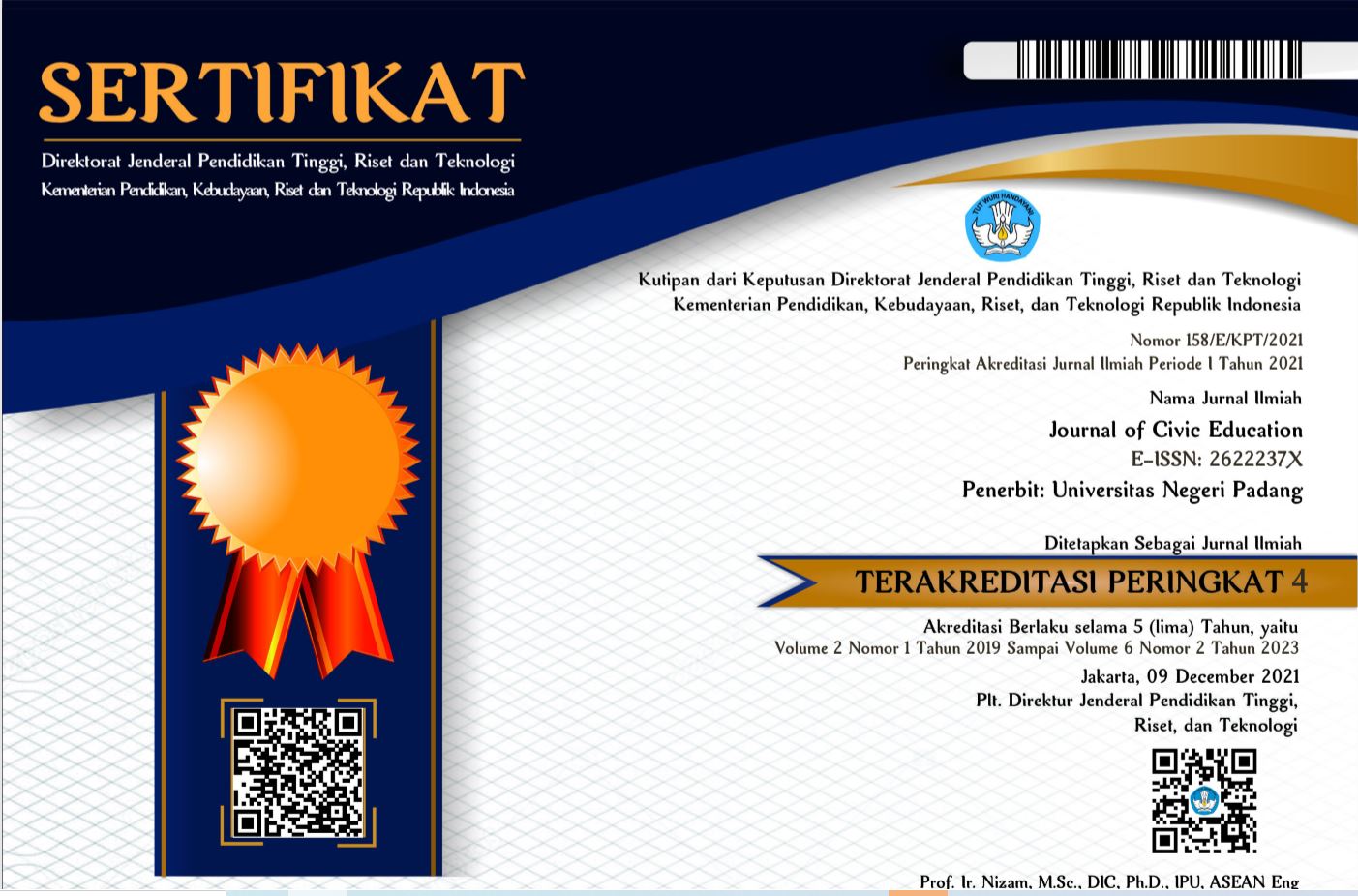Pemekaran Nagari: Transformasi Desa Adat di Kabupaten Pesisir Selatan
Abstract
This article discusses the changes and continuities in the structure and function of nagari, Minangkabau “traditional” village. Many scholars consider nagari as an autonomic “village republic” which was ruled by local leaders based on customary law. Even though nagari has been incorporated into the national administrative structure during colonial and post-independence of Indonesia, nagari is still regarded as the source of legitimacy on customary law. Especially in the 2000s, nagari has given more authority in the national legal system in Indonesia. In this article, I describe how nagari in Pesisir Selatan, West Sumatra is divided into smaller units. In order to get more budgets for village management from central government, local leaders and village heads chose to divide the nagari into smaller villages administratively but maintained large nagari informally as a single community bound by customary law. Interestingly, the new administrative villages are also called “nagari” and are given authority on customary law. This created a situation in which formal smaller but administrative nagari co-exists with larger yet informal nagari. What are the consequences of this dualism? By analyzing the process of nagari division, I describe how several different notions of “nagari” have developed in one village.
References
Antlov, H., Wetterberg, A., & Dharmawan, L. (2016). Village governance, community life, and the 2014 Village Law in Indonesia. Bulletin of Indonesian Economic Studies, 52(2), 161-183.
Arifah, R., Afrizal & Mutiara, V. I. (2019). Faktor Penyebab Pemekaran Nagari: Studi Kasus Nagari Koto Tinggi Maek Kabupaten Lima Puluh Kota. Jispo: Jurnal Ilmu Sosial Dan Ilmu Politik, 9(2), 135-158.
Bedner, A., & Y. Arizona. (2019). Adat in Indonesian law: A Promise for the Future or a Dead End? The Asian Pacific Journal of Anthropology. 20 (5), 416-434.
Benda-Beckmann von K. (1984). The Broken Stairways to Consensus: Village Justice and State Courts in Minangkabau. NJ: Foris Publications..
Benda-Beckmann, von F., & Benda-Beckmann von K. (2001). Reconstructing the Nagari: Decentralization in West Sumatra. Max Planck Institute for Social Anthropology Working Papers, 31, 1-45.
Benda-Beckmann von F., & Benda-Beckmann von K. (2013). Political and Legal Transformations of an Indonesian Policy: The Nagari from Colonisation to Decentralisation. New York: Cambridge University Press.
Dobbin, C. (1983). Islamic Revivalism in a Changing Peasant Economy: Central Sumatra, 1784-1847. London and Malmö: Curzon Press.Geertz, Clifford. (1973). The Interpretation of Cultures. New York: Basic Books.
Geertz, C. (1982). The way we think now: Toward an ethnography of modern thought. Bulletin of the American Academy of Arts and Sciences, 14-34.
Harmer, C. I. F. (2020). Kajian Hukum Terkait Pemekaran Nagari Persinggungan Peraturan Perundang-undangan dengan Hukum Adat di Provinsi Sumatera Barat (Graduation Thesis, Universitas Andalas).
Hayani, N., Putera, R. E., & Koeswara, H. (2022). Efektivitas Pekaran Nagari Sungai Aua Kecamatan SUNGAI AUR KABUPATEN PASAMAN BARAT. Jurnal Administrasi Publik dan Pemerintahan, 1(2), 44-56.
Henley, D., & Davidson S. J. (2007). Introduction: Radical Conservatism- the Protean Politics of Adat. In J. S. Davidson & D. Henley (Eds.), The Revival of Tradition in Indonesian Politics: The deployment of adat from colonialism to indigenism (pp. 1-49). Oxon: Routledge.
Kato, T. (1982). Matriliny and Migration: Evolving Minangkabau Traditions in Indonesia. Ithaca: Cornel University Press.
Mulia, B., Ritonga, S., & Nasution, I. (2021). Dampak Pemekaran Nagari Dalam Meningkatkan Pelayanan Publik Kepada Masyarakat. Jurnal Ilmu Pemerintahan, Administrasi Publik, dan Ilmu Komunikasi (JIPIKOM), 3(1), 12-18.
Ningsih, W., Arza, F. I., & Sari, V. F. (2020). Analisis Akuntabilitas Pengelolaan Alokasi Dana Desa. Jurnal Eksplorasi Akuntansi, 2(4), 3517-3532.
Nadia, S., & Magriasti, L. (2022). Peranan Tim Penataan Nagari Provinsi Sumatera Barat dalam Pelaksanaan Pemekaran Nagari di Kabupaten Agam. Jurnal Pendidikan Tambusai, 6(2), 16815-16826.
Oki, A. (1986). The Dynamics of Subsistence Economy in West Sumatra. In Andrew, T. & Tanabe, S. (eds.), History and Peasant Consciousness in South East Asia (pp.267-292). Osaka: National Museum of Ethnology.
Utama, T. S. J. (2019). Impediments to Establishing Adat Villages: A Socio-Legal Examination of the Indonesian Village Law. The Asia Pacific Journal of Anthropology. 21(1), 17-33.
Vel, J. A. C., & Bedner, A. W. (2015). Decentralization and Village governance in Indonesia: the Return to the Nagari and the 2014 Village Law. The Journal of Legal Pluralism and Unofficial Law. 47(3), 493-507.
Vel, J. A. C., & Makambombu, S. (2019). Strategic Framing of Adat in Land-Acquisition Politics in East Sumba. The Asia Pacific Journal of Anthropology. 20(5), 435-452.
Warman, K. (2010). Hukum Agraria dalam Masyarakat Majemuk: Dinamika Interaksi Hukum Adat dan Hukum Negara di Sumatra Barat. Jakarta: HuMa-Jakarta.
Wulandari, R., & Kadir, A. (2021). Peran Badan Permusyawaratan Desa dalam Pengelolaan Dana Desa. Strukturasi: Jurnal Ilmiah Magister Administrasi Publik, 3(2), 150-155.



